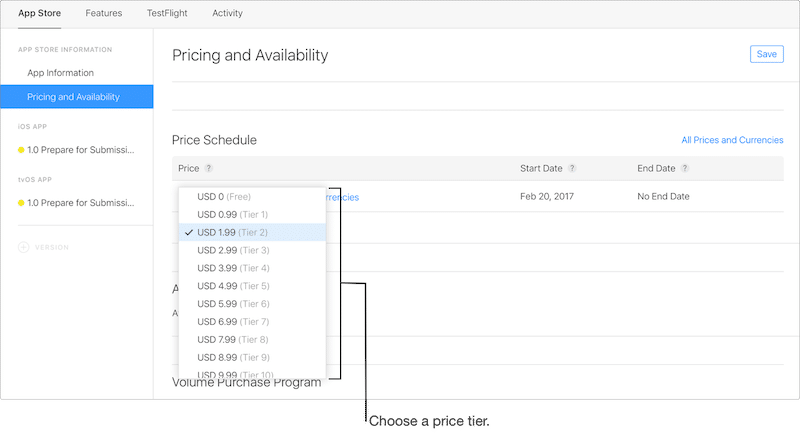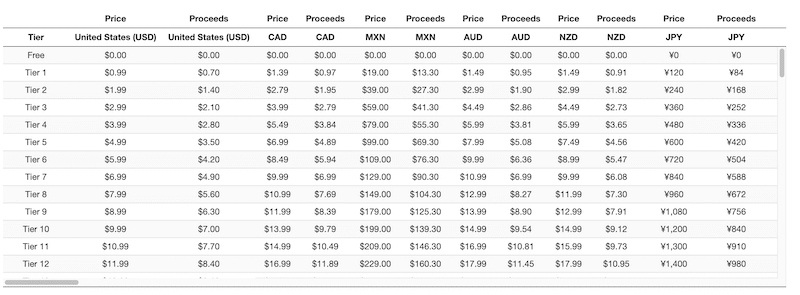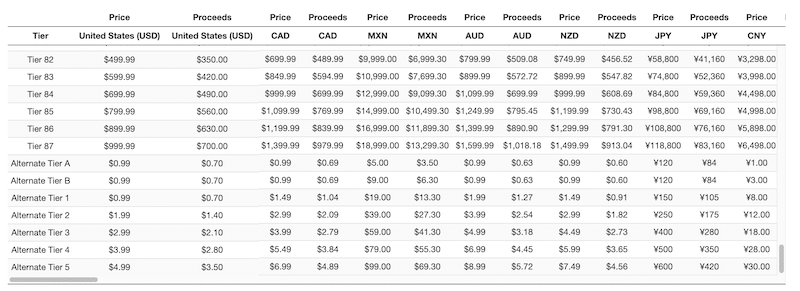Isn’t it surprising that on the App Store we can buy apps for $0.99, $1.99 and $2.99, respectively, while we don’t find there anything for $0.50, $1.20, or $2.76?
Even if it sounds a little bit weird when you hear about it for the first time, there is a method in this madness. As you will see in a moment, this solution called App Store “pricing tiers” or “pricing matrix”, has a rational explanation and it isn’t so strange as it may seem at first glance.
In this article, you’ll learn what the App Store pricing tiers exactly are, how they work, and why Apple decided to introduce them.
How does the system of tiers work in the App Store?
If you want to publish and sell your product on the Internet, one of the stages of the submission process is to define the price for which your customers can buy it. However, if you want to publish something through the App Store, there’s a little difference. To be more precise, you have to set a specific price tier. What does it mean?
The trick is that you cannot suggest a fixed product price yourself. Instead, you have to select one of the amounts, and thus a tier, already prepared and suggested by Apple. There’s no possibility to sell an app for, let’s say, $7.44 because Apple doesn’t put this price on the price list to choose from. The closest price you can choose is $7.99.
This is what choosing a price tier in USD looks like on the App Store
What you have to bear in mind choosing the app price is the currency of the country where your product will be distributed. Although your app will be available in all App Store territories by default, there’s a possibility to select a specific country. How many of them can you choose from?
On March 23, 2020, Apple made the following announcement on their website:
“App Store gives you the opportunity to connect with users in 155 countries or regions. We’re pleased to announce that the App Store will expand even farther this year with upcoming support for 20 new countries, allowing you to increase your impact and grow your business in new markets.”
For all these countries, Apple offers 94 price proposals (tiers) for now – 87 basic and 7 alternate which I write about below (an increase to 200 price tiers has already been announced). All these tiers are available for different currencies. There’s a whole range of them from United States Dollar through Euro to Swiss Franc, etc. They are displayed in reports as a 3 character currency code (USD, EUR, CHF).
Looking at the table below, containing the list of available tiers and attributed to them currencies and prices, will make you understand how it works.
The above App Store prices are valid as of 24/01/2019 (fragment of the table)
For example, if you want to sell your product to people from the United States and therefore set a price in USD (look at the second column called Price, United States), you can choose one pricing possibility starting from $0.99 (Tier 1) and ending with $999.99 (Tier 87). The multiple price tiers make it possible for everyone to find an amount corresponding to the value of the product.
What you must absolutely remember is the fact that Apple proposes these prices according to the current exchange rate. If you choose Tier 3 (look at the column on the left), the price of your app is distinct for different countries. For users registered in the US, it’s $2.99, in Canada $3.99 and in Italy €2,00.
What if you want to change the price of your app?
If you have a Paid Applications agreement, you can change the price for your app using different options: schedule pricing changes that have a definite start and end date, as well as permanent pricing changes that have no end. For example, you can set a promotional price only for a month and then return to the regular price.
Why did Apple introduce price tiers?
The main reason is quite simple.
Apple charges a 30% commission on each purchase of an app. Your proceeds are the customer price minus applicable taxes and Apple’s commission. By creating a price matrix, Apple avoids ending up with a very small amount of money in a financial settlement. This is just the most convenient method of settling international payments, allowing some kind of financial protection.
There is also the other side of the coin. Apple is a global company. They had to develop some organizing system that would help them manage transactions at the international level. As I wrote above, the App Store operates in 155 countries so far, and most of them have their own currency. Tier system is simplifying the global pricing process also for people who want to publish their apps. Can you imagine the situation when you have to provide a price separately for every country where you offered to sell your app?
Offering a price list largely based on exchange rates resulted also in other challenges. When taxes or foreign exchange rates change, Apple needs to update prices on the App Store. Another challenge of the price tier system was that it prevented price discrimination across regions. That’s why they decided to enlarge the price list and add seven alternate tiers, which gives developers many more possibilities in setting prices.
Apple introduced alternate tiers
The introduction of seven additional price tiers called alternate lets people set very low prices for apps in developing and emerging markets. It enables the sale of an app below the usual $0.99 price floor in countries like India, Indonesia, Mexico, or Turkey.
Look at the Alternate Tier A level. It allows selling apps in China for ¥1, which is equal to USD $0.14 now. Alternate Tiers A and B don’t integrate into prices in the developed markets (in these countries the prices are analogs to Tier 1, e.g $0.99 in the US).
App Store Alternate Tiers (the fragment of the table)
Will selling a product for such extremely low prices bring significantly profits for app owners? Some developers say that the “prices are cleaner and more consistent” and the result “is a very tiny increase in revenue but better than nothing”.
App Store for news apps publishers
Since the beginning of Price Tiers introduction, Apple has been constantly improving this system, paying huge attention to exchange rates: they add new tiers, change prices and expand the list of countries where the App Store can be available.
The convenient method of settling international payments for them, on the other hand, is not the most convenient for publishers wanting to sell a magazine app on the App Store. They can’t set any amount of money and are dependent on Apple’s currency conversion rates.
Adding to it the high costs of building your own magazine app (which you need to constantly maintain later), the alternative could be using platforms for building mobile apps.










